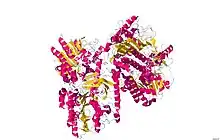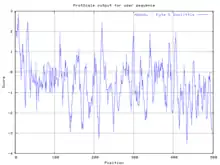Arylsulfatase B
| arylsulfatase B | |||||||
|---|---|---|---|---|---|---|---|
 Crystallographic structure of putative tetrameric arylsulfatase from Escherichia coli.[5] | |||||||
| Identifiers | |||||||
| Symbol | ARSB | ||||||
| NCBI gene | 411 | ||||||
| HGNC | 714 | ||||||
| OMIM | 253200 | ||||||
| RefSeq | NM_000046 | ||||||
| UniProt | P15848 | ||||||
| Other data | |||||||
| EC number | 3.1.6.12 | ||||||
| Locus | Chr. 5 p11-q13 | ||||||
| |||||||
| Clinical data | |
|---|---|
| Trade names | Naglazyme |
| Other names | Aryplase |
| AHFS/Drugs.com | Professional Drug Facts |
| License data |
|
| Pregnancy category |
|
| Routes of administration | Intravenous |
| ATC code | |
| Legal status | |
| Legal status |
|
| Identifiers | |
| CAS Number | |
| DrugBank | |
| UNII | |
| KEGG | |
| ChEMBL | |
| Chemical and physical data | |
| Formula | C2529H3843N689O716S16 |
| Molar mass | 55868.63 g·mol−1 |
Arylsulfatase B (N-acetylgalactosamine-4-sulfatase, chondroitinsulfatase, chondroitinase, acetylgalactosamine 4-sulfatase, N-acetylgalactosamine 4-sulfate sulfohydrolase, EC 3.1.6.12) is an enzyme associated with mucopolysaccharidosis VI (Maroteaux–Lamy syndrome).
Arylsulfatase B is among a group of arylsulfatase enzymes present in the lysosomes of the liver, pancreas, and kidneys of animals. The purpose of the enzyme is to hydrolyze sulfates in the body. ARSB does this by breaking down glycosaminoglycans (GAGs), which are large sugar molecules in the body. ARSB targets two GAGs in particular: dermatan sulfate and chondroitin sulfate.[7]
Over 130 mutations to ARSB have been found, each leading to a deficiency in the body. In most cases, the mutation occurs on a single nucleotide in the sequence. An arylsulfatase B deficiency can lead to an accumulation of GAGs in lysosomes,[7] which in turn can lead to mucopolysaccharidosis VI.
Used as a pharmaceutical drug, the enzyme is known under the International Nonproprietary Name galsulfase and is sold under the brand name Naglazyme.[8][9][10] Galsulfase was approved for medical use in the United States in May 2005 and in European Union in January 2006.[11][10] Galsulfase is indicated for long-term enzyme-replacement therapy in people with a confirmed diagnosis of mucopolysaccharidosis VI (MPS VI; N-acetylgalactosamine-4-sulfatase deficiency; Maroteaux-Lamy syndrome).[10]

Structure
The primary structure of Escherichia coli arylsulfatase B contains a primary sequence of 502 amino acids. Its secondary structure is quite complex, containing numerous alpha helices (20 total containing 138 residues) and beta sheets (21 strands total containing 87 residues).[5] The functional enzyme is believed to be a homo tetramer. Due to the complexity of arylsulfatase B's secondary structure, many hydrophobic and hydrophilic regions are present, as demonstrated by the Kyte-Doolittle hydropathy plot:
Medical uses
Galsulfase is used to treat adults and children who have mucopolysaccharidosis VI (MPS VI or Maroteaux-Lamy syndrome).[10] This disease is caused by the lack of an enzyme called N-acetylgalactosamine 4-sulfatase, which is needed to break down substances in the body called glycosaminoglycans (GAGs).[10] If the enzyme is not present, GAGs cannot be broken down and they build up in the cells.[10] This causes the signs of the disease, the most noticeable being a short body, a large head and difficulty moving about.[10] The disease is usually diagnosed in infants between one and five years of age.[10] Galsulfase has been shown to improve walking and stair-climbing capacity.[12]
The most common adverse reactions (≥10%) are: rash, pain, urticaria, pyrexia, pruritus, chills, headache, nausea, vomiting, abdominal pain and dyspnea.[12] The most common adverse reactions requiring interventions are infusion-related reactions.[12]
Galsulfase (N-acetylgalactosamine-4-sulfatase, recombinant human) was granted orphan drug designation by both the European Commission and the U.S. Food and Drug Administration (FDA).[13][14]
Role in cystic fibrosis
Expression and activity of ARSB were found to be related to the function of cystic fibrosis transmembrane conductance regulator (CFTR), the membrane channel deficient in cystic fibrosis. Measurements in cystic fibrosis cell line IB3 and its derivative cell line C38, which has a functional CFTR, showed increased ARSB activity and expression in the C38 line.[15] CFTR potentiator VRT-532 increased ARSB expression and activity in cystic fibrosis cells to the level in the normal bronchial epithelial cells.[16]
Role in malignancy
ARSB has been studied in a variety of cancers. Cultured normal mammary epithelial and myoepithelial cells had significantly higher ARSB activity than cultured malignant mammary cells.[17] Immunohistochemistry in the colon showed decreased membrane ARSB staining in colon cancer compared to normal colon, as well as in higher grade malignancies.[18] ARSB activity was lower in malignant than normal prostate tissue, and immunostaining of prostate tissue microarrays showed not only decreasing ARSB staining in prostate cancer tissue of a higher Gleason score, but also lower staining in patients with recurrent compared to non-recurrent cancer. ARSB staining was a greater predictor of recurrence than Prostate-specific antigen (PSA) test, indicating possible future role of ARSB as a prognostic biomarker of prostate cancer.[19] Further evidence of ARSB as a tumor suppressor was determined by molecular studies in cell cultures where ARSB was silenced by siRNA. The studies showed that decrease of ARSB leads to increase in free galectin-3, which attaches more strongly to less sulfated chondroitin 4-sulfate. Galectin-3 then acts on transcription factors AP-1 to increase expression of chondroitin sulfate proteoglycan versican and SP-1 to increase expression of WNT9A.[20][21] Another mechanism by which reduced ARSB is associated with carcinogenesis is through increased binding of SHP2 to more sulfated chondroitin 4-sulfate, which leads to increased phosphorylation of p38 and MITF with subsequently increased expression of GPNMB.[22]
Role in metabolism
Reduced sulfate availability due to impaired activity of ARSB has been linked to increased aerobic glycolysis, as shown by an increase in NADH and NADPH, reduced oxygen consumption, increased extracellular acidification and serum lactate, and a decline in mitochondrial membrane potential in ARSB-silenced cells and ARSB-null mouse tissues.[23]
Extra-lysosomal localization
Although primarily a lysosomal enzyme, ARSB was also found to localize at the cell membrane of hepatocytes, sinusoidal endothelial cells, and Kupffer cells in the liver, as well as in the apical membranes of normal and malignant colonic and prostatic epithelial cells, by immunohistochemistry and immunofluorescence studies. Membrane immunostaining in the colon and prostate was lower in malignant than in normal tissue and also was lower in higher grade malignancies.[18][19][24] ARSB activity assay in the membrane and cytosol fractions of cultured bronchial epithelial cells showed that the activity was several-fold greater in the membrane fraction.[25]
See also
- Aryl
- Sulfatase
References
- 1 2 3 GRCh38: Ensembl release 89: ENSG00000113273 - Ensembl, May 2017
- 1 2 3 GRCm38: Ensembl release 89: ENSMUSG00000042082 - Ensembl, May 2017
- ↑ "Human PubMed Reference:". National Center for Biotechnology Information, U.S. National Library of Medicine.
- ↑ "Mouse PubMed Reference:". National Center for Biotechnology Information, U.S. National Library of Medicine.
- 1 2 PDB: 3ED4; Patskovsky Y, Ozyurt S, Gilmore M, Chang S, Bain K, Wasserman S, Koss J, Sauder MJ, Burley SK, Almo SC (2010). "Crystal structure of putative arylsulfatase from Escherichia coli". To be Published. doi:10.2210/pdb3ed4/pdb.
- ↑ "Galsulfase (Naglazyme) Use During Pregnancy". Drugs.com. 11 December 2019. Retrieved 23 April 2020.
- 1 2 U.S. National Library of Medicine. "ARSB", Genetics Home Resource, 7 November 2010, Retrieved 22 November 2010
- ↑ Kim KH, Decker C, Burton BK (March 2008). "Successful management of difficult infusion-associated reactions in a young patient with mucopolysaccharidosis type VI receiving recombinant human arylsulfatase B (galsulfase [Naglazyme])". Pediatrics. 121 (3): e714–7. doi:10.1542/peds.2007-0665. PMID 18250117. S2CID 3298398.
- ↑ World Health Organization (2005). "International nonproprietary names for pharmaceutical substances (INN) : recommended international nonproprietary names (Rec. INN) : list 54". WHO Drug Information. 19 (3): 255. hdl:10665/73503.
- 1 2 3 4 5 6 7 8 "Naglazyme EPAR". European Medicines Agency (EMA). Retrieved 23 April 2020.
 This article incorporates text from this source, which is in the public domain.
This article incorporates text from this source, which is in the public domain. - ↑ "Drug Approval Package: Naglazyme (Galsulfase) NDA #125117". U.S. Food and Drug Administration (FDA). 9 September 2005. Retrieved 23 April 2020.
- 1 2 3 "Naglazyme- galsulfase solution". DailyMed. 14 April 2020. Retrieved 23 April 2020.
- ↑ "EU/3/01/025". European Medicines Agency (EMA). Retrieved 23 April 2020.
- ↑ "Naglazyme Orphan Drug Designation and Approval". accessdata.fda.gov. 24 December 1999. Retrieved 23 April 2020.
- ↑ Bhattacharyya S, Look D, Tobacman JK (2007). "Increased arylsulfatase B activity in cystic fibrosis cells following correction of CFTR". Clinica Chimica Acta; International Journal of Clinical Chemistry. 380 (1–2): 122–7. doi:10.1016/j.cca.2007.01.021. PMID 17324393.
- ↑ Bhattacharyya S, Feferman L, Tobacman JK (2016). "Effect of CFTR modifiers on arylsulfatase B activity in cystic fibrosis and normal human bronchial epithelial cells". Pulmonary Pharmacology & Therapeutics. 36: 22–30. doi:10.1016/j.pupt.2015.11.005. PMID 26656789.
- ↑ Bhattacharyya S, Tobacman JK (2007). "Steroid sulfatase, arylsulfatases A and B, galactose-6-sulfatase, and iduronate sulfatase in mammary cells and effects of sulfated and non-sulfated estrogens on sulfatase activity". The Journal of Steroid Biochemistry and Molecular Biology. 103 (1): 20–34. doi:10.1016/j.jsbmb.2006.08.002. PMID 17064891. S2CID 10970204.
- 1 2 Prabhu SV, Bhattacharyya S, Guzman-Hartman G, Macias V, Kajdacsy-Balla A, Tobacman JK (2011). "Extra-lysosomal localization of arylsulfatase B in human colonic epithelium". The Journal of Histochemistry and Cytochemistry. 59 (3): 328–35. doi:10.1369/0022155410395511. PMC 3201152. PMID 21378286.
- 1 2 Feferman L, Bhattacharyya S, Deaton R, Gann P, Guzman G, Kajdacsy-Balla A, Tobacman JK (2013). "Arylsulfatase B (N-acetylgalactosamine-4-sulfatase): potential role as a biomarker in prostate cancer". Prostate Cancer and Prostatic Diseases. 16 (3): 277–84. doi:10.1038/pcan.2013.18. PMC 3763935. PMID 23835622.
- ↑ Bhattacharyya S, Feferman L, Tobacman JK (2014). "Arylsulfatase B regulates versican expression by galectin-3 and AP-1 mediated transcriptional effects". Oncogene. 33 (47): 5467–76. doi:10.1038/onc.2013.483. PMC 4024465. PMID 24240681.
- ↑ Bhattacharyya S, Feferman L, Tobacman JK (2014). "Increased expression of colonic Wnt9A through Sp1-mediated transcriptional effects involving arylsulfatase B, chondroitin 4-sulfate, and galectin-3". The Journal of Biological Chemistry. 289 (25): 17564–75. doi:10.1074/jbc.M114.561589. PMC 4067192. PMID 24778176.
- ↑ Bhattacharyya S, Feferman L, Tobacman JK (2016). "Inhibition of Phosphatase Activity Follows Decline in Sulfatase Activity and Leads to Transcriptional Effects through Sustained Phosphorylation of Transcription Factor MITF". PLOS ONE. 11 (4): e0153463. Bibcode:2016PLoSO..1153463B. doi:10.1371/journal.pone.0153463. PMC 4831796. PMID 27078017.
- ↑ Bhattacharyya S, Feferman L, Tobacman JK (2016). "Restriction of Aerobic Metabolism by Acquired or Innate Arylsulfatase B Deficiency: A New Approach to the Warburg Effect". Scientific Reports. 6: 32885. Bibcode:2016NatSR...632885B. doi:10.1038/srep32885. PMC 5015117. PMID 27605497.
- ↑ Mitsunaga-Nakatsubo K, Kusunoki S, Kawakami H, Akasaka K, Akimoto Y (2009). "Cell-surface arylsulfatase A and B on sinusoidal endothelial cells, hepatocytes, and Kupffer cells in mammalian livers". Medical Molecular Morphology. 42 (2): 63–9. doi:10.1007/s00795-009-0447-x. PMID 19536613. S2CID 7523889.
- ↑ Bhattacharyya S, Solakyildirim K, Zhang Z, Chen ML, Linhardt RJ, Tobacman JK (2010). "Cell-bound IL-8 increases in bronchial epithelial cells after arylsulfatase B silencing due to sequestration with chondroitin-4-sulfate". American Journal of Respiratory Cell and Molecular Biology. 42 (1): 51–61. CiteSeerX 10.1.1.651.8409. doi:10.1165/rcmb.2008-0482OC. PMID 19346317.
Further reading
- Brunelli MJ, Atallah ÁN, da Silva EM (March 2016). "Enzyme replacement therapy with galsulfase for mucopolysaccharidosis type VI". Cochrane Database Syst Rev. 3: CD009806. doi:10.1002/14651858.CD009806.pub2. PMID 26943923.
- "Galsulfase (Naglazyme)". Common Drug Review. Ottawa (ON): Canadian Agency for Drugs and Technologies in Health (CADTH). November 2016. PMID 28121110.
- Ferreira CR, Gahl WA (May 2017). "Lysosomal storage diseases". Transl Sci Rare Dis. 2 (1–2): 1–71. doi:10.3233/TRD-160005. PMC 5685203. PMID 29152458.
External links
- Medical Dictionary, Arylsulfatase B function.
- Protein Data Base (PDB), Arylsulfatase structure.
- Genetics Home Reference, Arylsulfatase B function.
- Overview of all the structural information available in the PDB for UniProt: P15848 (Arylsulfatase B) at the PDBe-KB.
- "Galsulfase". Drug Information Portal. U.S. National Library of Medicine.
- Galsulfase at the US National Library of Medicine Medical Subject Headings (MeSH)



